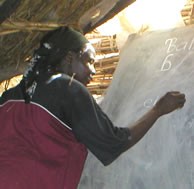Gor in Chad

Photo Source:
Anonymous
|
Send Joshua Project a map of this people group.
|
| People Name: | Gor |
| Country: | Chad |
| 10/40 Window: | Yes |
| Population: | 201,000 |
| World Population: | 201,000 |
| Primary Language: | Gor |
| Primary Religion: | Christianity |
| Christian Adherents: | 81.00 % |
| Evangelicals: | 10.00 % |
| Scripture: | New Testament |
| Ministry Resources: | Yes |
| Jesus Film: | No |
| Audio Recordings: | Yes |
| People Cluster: | Sara-Bagirmi |
| Affinity Bloc: | Sub-Saharan Peoples |
| Progress Level: |
|
Introduction / History
The Gor live in the south Chad close to the CAR border, in the Department "Logone Oriental". There are about 40 big villages (with up to 5,000 inhabitants) around Bodo, their commercial and cultural centre. Gor people have migrated to bigger Chadian cities such as Doba, Moundou, Sarh and N'Djamena as well as to other countries like CAR, Cameroon, Nigeria, France and even the United States. Their neighbours are: the Kaba to the west, the Mbay to the east, and the Bejonde and the Mango to the north. They are all considered "brothers" and their languages are very similar because they belong to the Sara language cluster.
The Gor are mostly farmers who grow millet and other cereals, cotton, peanuts, beans, potatoes and other tubercules in fertile soil. They raise small animals (sheep, goats, chickens) and cattle mostly for the field work. Village associations, called "groupements", run small businesses during the weekly markets held in the area. Their district is considered the "grainary" of the area which exports goods to commercial centres in Chad, CAR, Cameroon and Nigeria.
There are two health centres in Bodo, one Catholic and one Protestant. The government health centres have not operated since the war in 1979. Access to drinking water is a problem in the area due to the deep level of the groundwater. Less than half of the villages have a proper well, the others get their water by digging holes in the traditional way.
Since 1999 Tearfund has supported a literacy project in the Gor language which has reached over 5,000 adults so far. Literacy and post-literacy materials have been printed and distributed. Most schools in the villages have some classes (in French), but the complete primary education cycle is offered only in Bodo. The first missionaries reached the Bodo district in 1923. The people were very receptive to the Gospel and today most villages have at least one church.